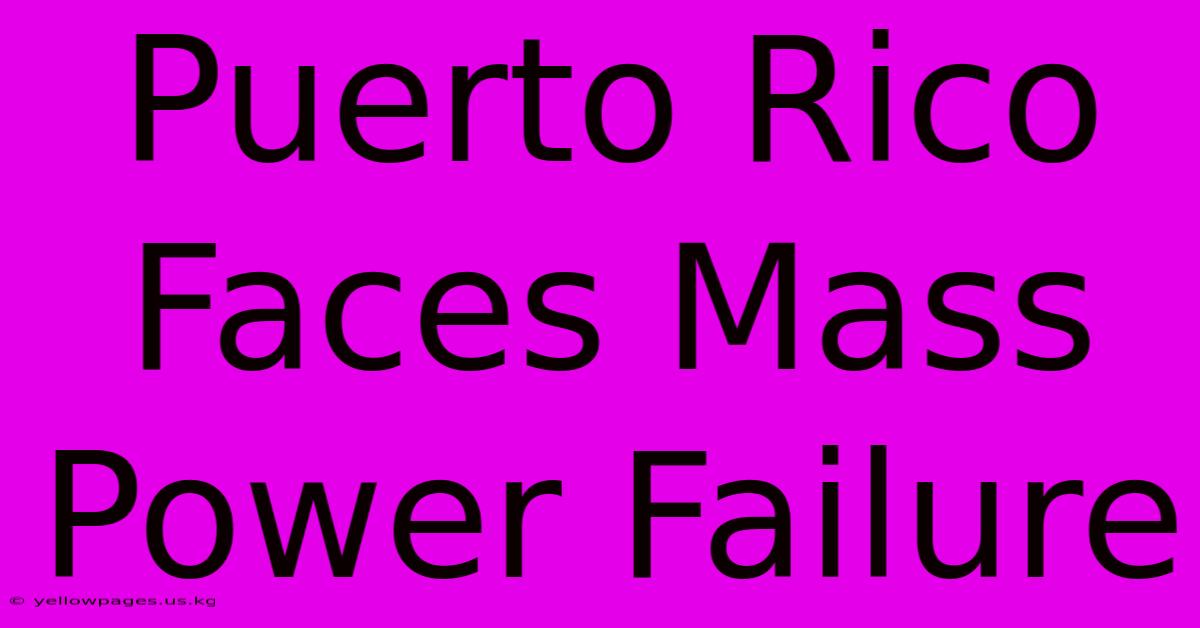Puerto Rico Faces Mass Power Failure

Discover more detailed and exciting information on our website. Click the link below to start your adventure: Visit Best Website yellowpages.us.kg. Don't miss out!
Table of Contents
Puerto Rico Faces Mass Power Failure: A Deep Dive into the Island's Ongoing Energy Crisis
Puerto Rico's electricity grid is, unfortunately, infamous for its unreliability. Recent events have once again thrust the island's energy woes into the spotlight, with a significant power failure impacting a large portion of the population. This article delves into the causes, consequences, and potential solutions to this persistent problem.
Understanding the Roots of the Crisis: Why Does Puerto Rico Keep Losing Power?
The island's power grid struggles stem from a complex interplay of factors:
1. Aging Infrastructure: A Crumbling System
Decades of neglect and insufficient investment have left Puerto Rico's power infrastructure in a state of disrepair. Outdated equipment, insufficient maintenance, and a lack of modernization have contributed significantly to frequent outages and widespread blackouts. The grid's vulnerability to natural disasters is exacerbated by this aging infrastructure.
2. Hurricane Maria's Lasting Impact: A Devastating Blow
Hurricane Maria, which struck Puerto Rico in 2017, dealt a catastrophic blow to the island's already fragile power grid. The storm caused widespread damage, leading to a prolonged blackout that lasted for months in some areas. While significant recovery efforts have been undertaken, the full restoration of the grid remains an ongoing challenge. The hurricane exposed the fragility and vulnerability of the existing system.
3. Bureaucracy and Inefficiency: A Slow Pace of Repair
Navigating the complexities of Puerto Rico's bureaucracy has hampered efforts to rebuild and modernize the grid. Permitting processes, regulatory hurdles, and procurement challenges have slowed down repairs and upgrades, prolonging the energy crisis. This bureaucratic red tape adds further delays to the recovery process.
4. Financial Constraints: A Lack of Resources
Securing the necessary funding for grid modernization and maintenance is another major obstacle. Puerto Rico faces significant economic challenges, and allocating sufficient resources to overhaul the power grid often competes with other pressing needs. The financial burden of rebuilding inhibits the speed and scale of necessary improvements.
The Consequences of Power Outages: Ripple Effects Across the Island
The consequences of these mass power failures extend far beyond the inconvenience of darkness. They affect:
- Public Health: Power outages disrupt access to essential medical services, particularly for those reliant on life-supporting equipment. Hospitals and clinics struggle to function effectively without reliable electricity.
- Economic Activity: Businesses suffer losses due to disruption, impacting the island's overall economic growth. Tourism, a vital sector, is significantly affected by unreliable power.
- Education: Schools and universities face disruptions, impacting student learning and educational progress.
- Daily Life: Basic necessities like refrigeration, water supply, and communication are significantly compromised.
Potential Solutions: A Path Forward for Puerto Rico
Addressing Puerto Rico's energy crisis requires a multi-pronged approach:
- Modernization of the Grid: Investing in modern, resilient infrastructure is crucial. This includes upgrading transmission lines, substations, and generation facilities.
- Diversification of Energy Sources: Reducing reliance on fossil fuels and exploring renewable energy sources like solar and wind power can improve energy security and reduce the environmental impact.
- Improved Governance and Transparency: Streamlining regulatory processes and enhancing transparency in decision-making can accelerate the pace of repairs and modernization.
- Strategic Investment: Securing adequate funding from both public and private sources is critical to supporting long-term solutions.
Conclusion:
The recent mass power failure in Puerto Rico underscores the urgency of addressing the island's long-standing energy crisis. A comprehensive and sustained effort, involving modernization, diversification, improved governance, and substantial investment, is essential to build a more resilient and reliable power grid for the future. The path to a stable and sustainable energy future requires collaboration, commitment, and a long-term vision. The consequences of inaction are simply too severe to ignore.

Thank you for visiting our website wich cover about Puerto Rico Faces Mass Power Failure. We hope the information provided has been useful to you. Feel free to contact us if you have any questions or need further assistance. See you next time and dont miss to bookmark.
Featured Posts
-
Uk Sports Network Kentucky Mens Basketball Games
Jan 01, 2025
-
Northern Lights California New Years Eve
Jan 01, 2025
-
Baylor Vs Lsu Nussmeier Upset
Jan 01, 2025
-
Baylor Vs Lsu Prediction Game Preview
Jan 01, 2025
-
Klatts 2024 25 Cfp Quarterfinals
Jan 01, 2025
